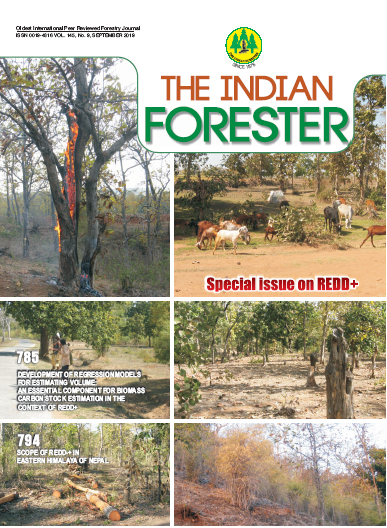Soil Organic Carbon Stocks as Influenced by Forest Management and Socio-Economic Characteristics of Community Forest User Groups in Three Districts of Central Nepal
DOI:
https://doi.org/10.36808/if/2019/v145i9/148714Keywords:
Community Forest, Agroforestry, Livelihood, Non-Timber Forest Product, REDD.Abstract
This paper examines the forest-based livelihood strategy of the forest user groups and the prospects and potential benefits of soil carbon sequestration through REDD (Reducing Emissions from Deforestation and Forest Degradation) program in three districts of Central Nepal, namely Chitwan, Gorkha and Rasuwa. The objectives were to assess forest-based livelihood strategy and soil organic carbon (SOC) stocks in the community forest and agro-forest systems. Data were collected through a household survey, focus group discussions and laboratory experiments. Findings from this study showed that crop productivity has increased after establishment of community forest. Community forest users groups (CFUGs) use of fuelwood and leaf litter was higher than other non-timber forest products (NTFPs). The CFUGs of community forest managed by women (Chelibeti and Laxmimahila) have used biogas as an alternative energy source compared with men-managed community forest. Farmers had participated in various training courses including vegetable farming, livestock management and forest inventory. The study revealed that forest soil has a high potential to sequester carbon. The highest value of SOC stock (374 Mg/ha) was recorded in higher elevation forestland of Rasuwa district followed by Improved Agroforestry (IA) (244 Mg/ha) and Traditional Agroforestry (TA) (210 Mg/ha). The comparison of SOC stock within the community forests and agroforestry with other forests, showed that wellmanaged forests had two to three times as much SOC stock as degraded forests. The estimation of potential SOC gained indicated the likely future benefits of enhancing SOC stock through community forests and agroforestry.References
Anders A.M., Roe G.H., Hallet B., Montgomery D.R., Finnegan N.J. and Putkonen J. (2006). Spatial patterns of precipitation and topography in the Himalaya. Geological Society of America, Special Paper, 398:39-53.
Arnold J.M. (2001). Forestry, poverty and aid: CIFOR Bogor, Indonesia.
Awasthi K., Singh B. and Sitaula B.K. (2005). Profile carbon and nutrient levels and management effect on soil quality indicators in the Mardi watershed of Nepal. Acta Agriculturae Scandinavica Section B-Soil and Plant, 55(3):192-204.
Benbi D.K., Brar K., Toor A.S., Singh P. and Singh H. (2011). Soil carbon pools under poplar-based agroforestry, rice-wheat, and maize-wheat cropping systems in semi-arid India. Nutrient Cycling in Agroecosystems, 92(1):107-118.
Bhattarai T.P., Skutsch M., Midmore D.J. and Rana E.B. (2012). The Carbon Sequestration Potential of Community based Forest Management in Nepal. The International Journal of Climate Change: Impacts and Responses, 3(2):233-254.
Bhattacharya A.K. and Basnyat B. (2005). Decentralisation and community forestry programmes in Nepal: issues and challenges. International Forestry Review, 7:147-55.
Blake G.R. and Hartge, K.H. (1986). Bulk density. In: Klute, A.L. (Ed.), Methods of Soil Analysis Part 1 Physical and Mineralogical Methods Agronomy Monographs, second ed. ASA; SSSA, Madison. WI, USA, PP. 425–442.
Brabben T., Angood C., Skutsch J. and Smith L. (2004). Irrigation can sustain rural livelihoods: Evidence from Bangladesh and Nepal. HR Wallingford, DFID and Imperial College London.
DFID (2000): Sustainable Livelihoods Guidance Sheets. Department for International Development. 94 Victoria Street, London SW1E 5JL.
FAO, (2010). Global forest resource assessment, Food and Agriculture Organization, Rome
Giri K., Pokhrel B. and Darnhofer, I. (2008). In the absence of their men: Women and forest management in the Mid-hills of Nepal. Environmental Economics and Investment Assessment II, 108:295-304.
Gnyawali T.P. (2007). Understanding the Changes in Livelihoods Assets with Locals: A Case study from Kanchenjunga Conservation Area Project, Nepal. Kathmandu, WWF Nepal.
Jobbagy E.G. and Jackson R.B. (2000). The vertical distribution of soil organic carbon and its relation to climate and vegetation. Ecological Applications, 10(2):423-436.
Khanal Y., Sharma R. and Upadhyaya C. (2010). Soil and vegetation carbon pools in two community forests of Palpa district, Nepal. Banko Janakari, 20(2):34-40.
Karky B.S. and Skutsch M. (2010). The cost of carbon abatement through community forest management in Nepal Himalaya. Ecological Economics, 69(3):666-672.
Karousakis K. (2007). Incentives to reduce GHG emissions from deforestation: lessons learned from Costa Rica and Mexico, Organization for Economic Co-operation and Development (OECD), Paris.
Nelson D.W. and Sommers L.E. (1982). Total carbon, organic carbon, and organic matter, In: AL Page et al. (eds.), Methods of soil analysis, 2nd edn, Part 2. Chemical and microbiological properties, 539-579.
Odihi J. (2003). Deforestation in afforestation priority zone in Sudano-Sahelian Nigeria. Applied Geology, 23:227-259.
Ojha H., Persha L. and Chhatre A. (2009). Community forestry in Nepal: A policy innovation for local llivelihoods, International Food Policy Research Institute, IFPRI Discussion Paper 00913, 2020 Vision Initiative.
Pandit B.H. and Thapa G.B. (2003). A tragedy of non-timber forest resources in the mountain commons of Nepal. Environmental conservation, 30(03):283-292.
Pokharel B., Stadtmuller T. and Pfund J. (2005). From degradation to restoration: An assessment of the enabling conditions for community forestry in Nepal. Intercooperation, Swiss Foundation for Development and International Cooperation, Switzerland.
Prichard S.J., Peterson D.L. and Hammer R.D. (2000). Carbon distribution in subalpine forests and meadows of the of the Olympic Mountain, Washington. Soil Science Society of America Journal 64(5):1834-1845
Shrestha B.M. and Singh B.R. (2008). Soil and vegetation carbon pools in a mountainous watershed of Nepal. Nutrient cycling in Agroecosystems, 81(2):179-191.
Shrestha B., Sitaula B., Singh B. and Bajracharya R. (2004). Soil organic carbon stocks in soil aggregates under different land use systems in Nepal. Nutrient cycling in Agroecosystems, 70 (2): 201-213.
Veldkamp E. (1994). Organic carbon turnover in three tropical soils under pasture after deforestation. American Society of Agronomy, 58(1):175-180.
WB. (2001). Community forestry in Nepal, Precis, World Bank Operations Evaluation Department, No. 217, Washington DC.
Wairiu M. and Lal R. (2003). Soil organic carbon in relation to cultivation and topsoil removal on sloping lands of Kolombangara, Solomon Islands. Soil and Tillage Research, 70(1):19-27.
Downloads
Downloads
Published
How to Cite
Issue
Section
License
Unless otherwise stated, copyright or similar rights in all materials presented on the site, including graphical images, are owned by Indian Forester.





